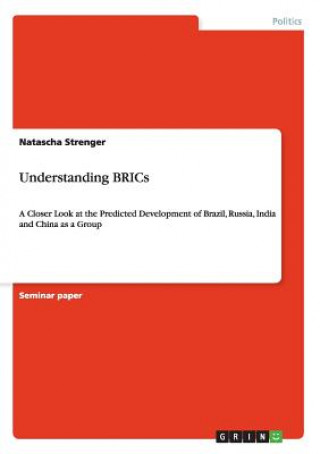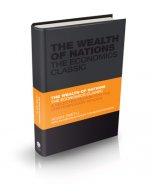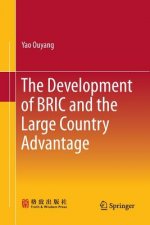
Kód: 01677915
Understanding BRICs
Autor Natascha Strenger
Seminar paper from the year 2011 in the subject Politics - Political Systems - General and Comparisons, grade: 1,3, Ruhr-University of Bochum (Fakultät für Sozialwissenschaften), course: Emerging Powers in International Affairs, l ... celý popis
- Jazyk:
 Angličtina
Angličtina - Väzba: Brožovaná
- Počet strán: 24
Nakladateľ: Grin Publishing, 2012
- Viac informácií o knihe

Mohlo by sa vám tiež páčiť
-

BRICS: A Very Short Introduction
13.56 € -

Skin Care and Cosmetic Ingredients Dictionary
42.63 € -

Fifty Things that Made the Modern Economy
11.65 € -18 % -

Diplomacy
17.18 € -20 % -

Wealth of Nations
13.06 € -23 % -

The Concise Art of Seduction
9.95 € -16 % -

BRICS
131.12 € -

Do German Capital Markets React When Corporate Insiders Exercise Stock Options?
57.51 € -

Harry Potter: The Dark Arts Tiny Book
11.25 € -13 % -

John Derian Paper Goods: Calm Cat 750-Piece Puzzle
19.80 € -5 % -

Development of BRIC and the Large Country Advantage
137.05 € -

Beauty of Horror 1: A GOREgeous Coloring Book
15.98 € -16 % -

Bleach Box Set 1
161.48 € -13 % -

Higher Education in the BRICS Countries
137.05 € -

Like Lana
18.39 € -

Love Me, Love Me Not, Vol. 3
8.74 € -22 % -

Liberte
10.05 € -12 % -

BRICS Studies
204.52 € -

Heroes of Jadotville
19.60 € -13 % -

Energy Oracle Cards
24.83 € -7 % -

Algerie-Togo
3.31 € -6 % -

Pluricentricity
176.67 € -

Building a Future with BRICs
69.57 € -

Droga Icemana. Metoda Wima Hofa. Ćwiczenia oddechowe, trening z zimnem oraz praca z umysłem.
5.82 € -44 % -

Sovákova kuchařka
7.73 € -21 % -

Triathlon Anatomie
20.91 € -

Intimní splynutí
10.05 € -15 % -

Vorläufiger Rechtsschutz und aufschiebende Wirkung
30.56 € -5 % -

Handbuch der Dogmatik
109.40 € -

Mis primeros cuentos
18.79 € -

Bric-a-brac
52.48 € -

Bone 08 - Schatzjäger
14.17 € -10 % -

Entdecke die Amphibien
16.98 € -

PublicPress Rad- und Wanderkarte Bergstraße, Odenwald Nord
9.84 € -

Anno Domini, Europa
15.88 € -5 %
Darčekový poukaz: Radosť zaručená
- Darujte poukaz v ľubovoľnej hodnote, a my sa postaráme o zvyšok.
- Poukaz sa vzťahuje na všetky produkty v našej ponuke.
- Elektronický poukaz si vytlačíte z e-mailu a môžete ho ihneď darovať.
- Platnosť poukazu je 12 mesiacov od dátumu vystavenia.
Viac informácií o knihe Understanding BRICs
Nákupom získate 103 bodov
 Anotácia knihy
Anotácia knihy
Seminar paper from the year 2011 in the subject Politics - Political Systems - General and Comparisons, grade: 1,3, Ruhr-University of Bochum (Fakultät für Sozialwissenschaften), course: Emerging Powers in International Affairs, language: English, abstract: About ten years ago, Jim O Neil at the well-known investment bank Goldman Sachs coined the acronym BRIC for four emerging countries that were regarded to have a common potential of shaping global markets in the not-too-distant future: Brazil, Russia, India and China. In 2003, Goldman Sachs published a report named Dreaming with BRICs: The Path to 2050 . Its key message was that the economies of these four countries together, which at that time made up only 15% of the global economy, could by 2050 be larger than those of the (former) G6. They claimed that, given that their predictions come true, the list of the world s major economies could look very different from today s in less than 40 years a perspective which must naturally have an influence on investing behavior around the globe (see Wilson, Purushotaman 2003). The reasons for these expectations were the BRICs economic growth rates, which topped those of the industrialized nations by far, as well as their huge share of global population which promised emerging masses of consumers.In 2010, Goldman Sachs could proudly announce the fulfillment of their 2001 predictions (Wilson et al.). The past decade had indeed seen a rise in political and economic power of these emerging countries, so, according to Goldman Sachs, there were no reasons to doubt that the BRICs future growth would as well be satisfying their forecasts (ibid. 2). Another report from December 2009, which concentrated on the BRICs survival of the global financial crisis had even confirmed that these countries (with the sole exception of Russia) were emerging healthier from it than the industrialized world a development which gave reason to expect yet better long-term performance than they had originally prophesized ten years ago (O Neill, Stupnytska).However, critics argue that the entire concept of BRIC has flaws it might appear forced to group four countries that seem to have very little in common. The prediction of their future role in global affairs seems rather bold and even if in terms of economics the BRICs fulfill the expectations what does this mean for their general role in world affairs? This paper shall have a closer look at the BRIC group and its actual and predicted development. The sense of an analytical concept that was applied to four such different countries shall be examined by pointing out there commonalities and differences.
 Parametre knihy
Parametre knihy
Zaradenie knihy Knihy po anglicky Society & social sciences Politics & government Political ideologies
41.02 €
- Celý názov: Understanding BRICs
- Autor: Natascha Strenger
- Jazyk:
 Angličtina
Angličtina - Väzba: Brožovaná
- Počet strán: 24
- EAN: 9783656222316
- ISBN: 3656222312
- ID: 01677915
- Nakladateľ: Grin Publishing
- Hmotnosť: 45 g
- Rozmery: 210 × 148 × 2 mm
- Dátum vydania: 25. June 2012
Obľúbené z iného súdka
-

The Communist Manifesto
3.51 € -24 % -

The Unabomber Manifesto
13.77 € -

Capital
5.92 € -19 % -

Mein Kampf
30.46 € -13 % -

German Ideology
18.49 € -8 % -

How to be a conservative
18.19 € -21 % -

The Communist Manifesto
2.30 € -

Mein Kampf
29.15 € -

Notes on Nationalism
3.51 € -24 % -

Road to Serfdom
17.79 € -2 % -

Rules for Radicals
13.97 € -11 % -

Anatomy of Fascism
12.16 € -20 % -

The Virtue of Nationalism
27.44 € -16 % -

Fanged Noumena - Collected Writings 1987-2007
30.56 € -

Psychopolitics
11.35 € -14 % -

State and Revolution
7.23 € -

Mein Kampf
35.99 € -

Communist Manifesto and Das Kapital
8.84 € -23 % -

Communist Manifesto
7.73 € -17 % -

Real North Korea
14.17 € -23 % -

Post-scarcity Anarchism
16.68 € -16 % -
![What Is to Be Done? [Burning Questions of Our Movement] What Is to Be Done? [Burning Questions of Our Movement]](https://media.libris.to/jacket/08800888t.jpg)
What Is to Be Done? [Burning Questions of Our Movement]
8.14 € -

New Way Of The World
28.95 € -5 % -

Capitalism, Socialism and Democracy
15.17 € -

Coming Insurrection
12.76 € -16 % -

Socialism
14.77 € -4 % -

Mass Psychology of Fascism
16.28 € -23 % -

New Faces of Fascism
20.50 € -20 % -

Essential Writings of Karl Marx
21.61 € -

Marx'S Das Capital for Beginners
16.58 € -8 % -

Fascism for the Million
31.16 € -

Irreversible Damage
23.02 € -22 % -

American Fuehrer
44.13 € -10 % -

Up from Liberalism
17.39 € -

Nations and Nationalism
36.99 € -

Origins and Doctrine of Fascism
61.33 € -

Law
10.45 € -

Marx's Fate
49.06 € -

Dogs of the Sinai
27.14 € -

Writings of Rosa Luxemburg
21.61 € -

Blackshirts and Reds
15.17 € -15 % -

Imagined Communities
16.18 € -14 % -

The Rape of the Mind
14.57 € -

Brainwashed
17.49 € -17 % -

Why Liberalism Failed
17.99 € -10 % -

Rights of Man, Common Sense, and Other Political Writings
7.73 € -23 % -

Communist Manifesto
5.72 € -

Capital
18.29 € -20 % -

Brief History of Neoliberalism
23.92 €
Osobný odber Bratislava a 2642 dalších
Copyright ©2008-24 najlacnejsie-knihy.sk Všetky práva vyhradenéSúkromieCookies



 21 miliónov titulov
21 miliónov titulov Vrátenie do mesiaca
Vrátenie do mesiaca 02/210 210 99 (8-15.30h)
02/210 210 99 (8-15.30h)